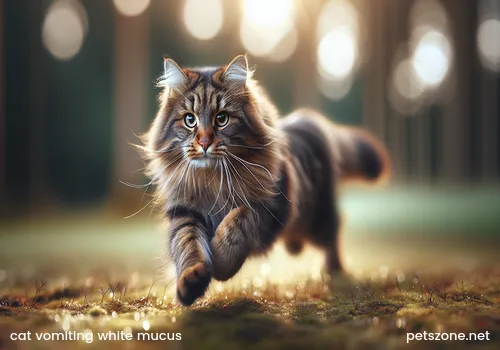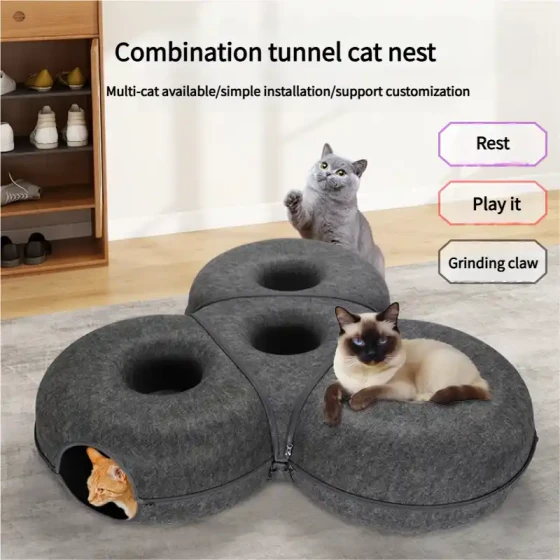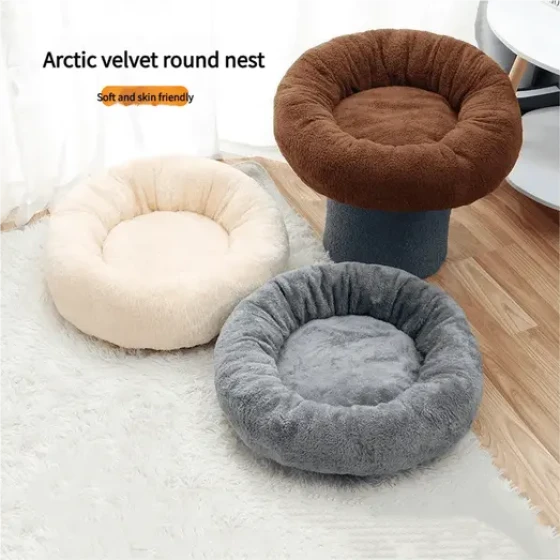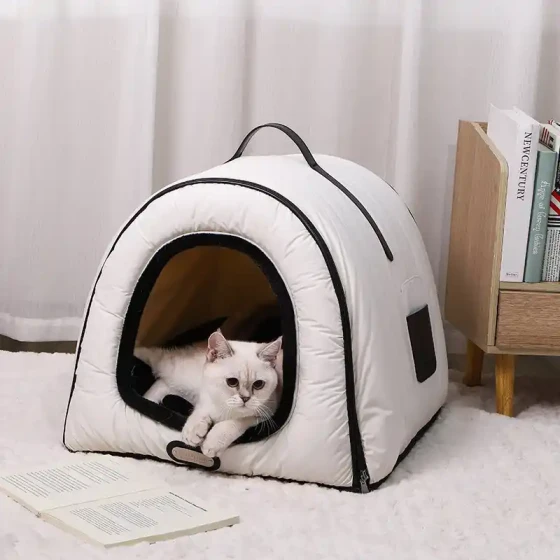Cat vomiting white sticky mucus is feline panleukopenia_accompanied by tearing symptoms to be vigilant
Cats vomiting white sticky mucus accompanied by tearing is indeed a worrying situation for many pet owners. Although these two symptoms may indicate health problems in cats, please remember that diagnosing "feline panleukopenia" based solely on these signs is not accurate. These symptoms can be caused by a variety of reasons, ranging from relatively mild digestive discomfort to severe diseases requiring urgent treatment. The most important thing is that when cats show these symptoms, vigilance should be heightened, and professional veterinary advice should be sought promptly to obtain accurate diagnosis and timely treatment.

Why do cats vomit white sticky mucus?
Cats vomiting white sticky mucus usually means the stomach is empty or irritated, and the vomit mainly consists of a mixture of gastric acid, bile, saliva, and mucous membrane. Imagine feeling nauseous with an upset stomach and vomiting acidic liquid like a person. Possible causes include:
- Prolonged fasting: If a cat hasn't eaten for a long time, gastric acid accumulates and irritates the stomach lining, causing white foamy vomit. It’s like when we’re too hungry and our stomach burns uncomfortably.
- Indigestion or stomach discomfort: Eating too fast, consuming inappropriate food, or sudden changes in cat food can cause indigestion and gastric inflammation leading to vomiting.
- Hairball syndrome: Cats lick themselves to clean, swallowing hair in the process. Small amounts of hair usually pass through smoothly, but excessive hair clumping into hairballs can irritate the gastrointestinal tract, causing vomiting sometimes with white foam mixed with hair.
- Ingestion of foreign objects: Curious cats may accidentally swallow threads, plastics, small toys, or other foreign objects that irritate or block the digestive tract causing vomiting.
- Gastritis or enteritis: Inflammation of the gastrointestinal tract is a common cause of vomiting, which may be caused by bacteria, viruses, parasites, or food allergies.
- Other systemic diseases: Diseases in the liver, kidneys, pancreas, and other organs may also indirectly cause gastrointestinal symptoms including vomiting.
Why do cats have tearing eyes?
Tearing in cats, medically called epiphora, is not a symptom unique to a single disease but can have many causes:
- Eye irritation or foreign bodies: Dust, smoke, chemicals, or inward-growing eyelashes may irritate the eyes and cause tearing.
- Eye infections: Bacterial, viral (such as feline herpesvirus, calicivirus), or fungal infections can cause conjunctivitis, keratitis, and other eye diseases that result in redness, swelling, tearing, sometimes accompanied by increased eye discharge.
- Allergic reaction: Allergies to pollen, dust mites, food, or other substances can cause eye itching and tearing.
- Tear duct obstruction: The cat’s tear duct system may become blocked due to inflammation, infection, or congenital anomalies, leading to tears overflowing outside instead of draining normally.
- Upper respiratory tract infection: Many infections that cause sneezing and nasal discharge (such as feline rhinotracheitis) also affect the eyes causing tearing.
Is cat vomiting white sticky mucus accompanied by tearing a sign of feline panleukopenia?
The colloquial term "cat plague" usually refers to feline panleukopenia (Feline Panleukopenia Virus, FPLV), a highly contagious and deadly disease especially threatening to kittens. The feline panleukopenia virus mainly attacks rapidly dividing cells in cats’ bodies, particularly intestinal and bone marrow cells, causing severe gastrointestinal symptoms and sharp decreases in white blood cell counts.
Typical symptoms of feline panleukopenia include:
- High fever or hypothermia
- Depression, extreme weakness
- Loss of appetite, anorexia
- Severe vomiting, often yellow bile or blood-stained vomitus
- Profuse diarrhea, possibly bloody and foul-smelling
- Rapid dehydration
- Sharp drop in white blood cell count
Although vomiting is common in feline panleukopenia, the typical vomit is yellow-green or blood-tinged rather than simple white foam. Also, the core pathological change in feline panleukopenia is viral attack on bone marrow causing leukopenia, leading to immune suppression, secondary infections, and severe systemic symptoms.
Tearing is not a typical or primary symptom of feline panleukopenia. The virus usually does not directly damage eye tissue. If a feline panleukopenia cat shows tearing, it is more likely due to secondary bacterial or viral eye infections resulting from immune deficiency, or poor eye condition due to extreme weakness and dehydration.
Therefore, cats vomiting white sticky mucus accompanied by tearing do indicate illness and need immediate veterinary care, but these two symptoms alone cannot directly diagnose feline panleukopenia. Many other conditions such as upper respiratory infections with gastrointestinal discomfort, mixed infections from multiple pathogens, or severe foreign body obstruction can cause vomiting and tearing simultaneously.
When should you be highly vigilant and seek emergency vet care?
Although vomiting white foam and tearing are not equivalent to feline panleukopenia, they are SOS signals from your cat. The following situations require heightened vigilance and urgent veterinary consultation:
- Persistent or worsening vomiting or tearing symptoms.
- Depressed spirit, less lively than usual.
- Loss of appetite or refusal to eat.
- Diarrhea, especially loose, watery, bloody, or mucous stools.
- Abnormal temperature (too high or too low). Measure rectal temperature with a pet thermometer; normal cat temperature ranges from approximately 38°C to 39.2°C.
- Clear signs of dehydration (reduced skin elasticity, sunken eyes, dry sticky gums).
- Rapid or labored breathing.
- Behavioral abnormalities like hiding, avoiding touch, vocalizing in pain.
These symptoms indicate potentially serious illness that requires immediate professional intervention.
How will veterinarians diagnose?
Veterinarians will ask detailed history including symptom onset, frequency, dietary changes, vaccination status, and if the cat had contact with other cats, followed by thorough physical examination.
To determine causes, vets may recommend tests such as:
- Complete blood count (CBC): Key test for diagnosing feline panleukopenia by checking white blood cell counts. Very low counts raise strong suspicion of feline panleukopenia.
- Biochemical tests: Assess liver, kidney, and other organ function.
- Fecal examination: Detect parasites or certain bacteria.
- Feline panleukopenia virus (FPLV) rapid test or PCR: Direct detection of virus in feces or blood.
- Imaging (X-ray or ultrasound): Check for foreign bodies, obstructions, or structural abnormalities in the digestive tract.
- Eye examination: Detailed inspection of eye structures and functions to identify causes of tearing.
Based on these results vets can make accurate diagnoses and plan appropriate treatments.
How to prevent feline panleukopenia and other common diseases?
Though the symptoms discussed do not equal feline panleukopenia, prevention of feline panleukopenia and other infectious diseases is crucial for cat health:
- Timely vaccination: Follow vet recommendations to vaccinate cats on schedule with triple or quadruple vaccines that effectively prevent feline panleukopenia, rhinotracheitis, and calicivirus infections. Vaccines are the most effective and economical prevention, like equipping cats with a "protective armor."
- Maintain environmental hygiene: Regularly clean cats’ living spaces, food bowls, water bowls, and litter boxes to reduce pathogen spread.
- Avoid exposure to sick cats: Prevent immunocompromised or unvaccinated cats from contacting unknown or ill cats.
- Regular health checks: Even apparently healthy cats should have comprehensive annual check-ups to detect and treat potential health issues early.
- Proper nutrition: Provide balanced, easily digestible cat food and avoid frequent diet changes to lower indigestion risk.
Frequently Asked Questions
- Q: Does vomiting white sticky mucus always mean feline panleukopenia?
- A: Not necessarily. Vomiting white mucus can be caused by many reasons including fasting, indigestion, hairball, gastritis etc. Though feline panleukopenia may cause vomiting, it usually is not characterized by white mucus alone and includes more severe systemic signs.
- Q: Besides feline panleukopenia, what other causes lead to cat vomiting white mucus and tearing?
- A: There are many causes including upper respiratory infections, eye infections, gastrointestinal inflammation, foreign bodies, allergies, and systemic diseases. When these two symptoms appear together, various possibilities must be considered.
- Q: If my cat vomits white mucus and has tearing eyes, should I take it to the vet immediately?
- A: Yes, it’s strongly recommended to visit a vet promptly, especially if accompanied by depression, loss of appetite, diarrhea, or abnormal temperature. Veterinarians can identify the cause and provide treatment.
- Q: Can feline panleukopenia be cured?
- A: Feline panleukopenia is a serious disease with high mortality, especially in kittens. However, with timely detection and professional symptomatic treatment including fluid and electrolyte therapy, antibiotics to control secondary infections, and nutritional support, some cats can recover. Early diagnosis and active treatment are critical.
Summary
Vomiting white sticky mucus accompanied by tearing in cats is a health warning that needs attention. Though not exclusive to feline panleukopenia and insufficient alone to diagnose it, these symptoms indicate a problem in the cat’s body. Always stay vigilant, closely observe additional signs, and seek professional veterinary help promptly. Only through detailed examinations can the exact cause be diagnosed and the most suitable treatment be administered, helping your beloved cat recover quickly. Remember, early detection and treatment are key to improving cure rates and reducing suffering in many feline diseases.


